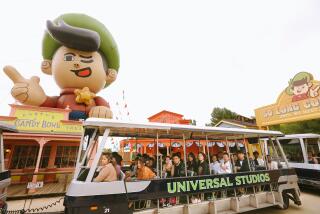Relocated roller coasters keep rollin’ on
A survivor of Hurricane Katrina is drawing big crowds at Six Flags Magic Mountain in Valencia.
The Road Runner Express roller coaster was moved to the Southern California amusement park from Six Flags New Orleans, where it operated for more than 10 years until the 2005 hurricane inundated the now-closed park.
Reclaimed roller coasters are not new to the theme park industry. But more rides have been recycled in the last decade with the closure of several parks that have been victims of the economic recession or natural disasters such as Hurricane Katrina.
And with the economy still sputtering, theme parks are more likely to consider moving and renovating a used ride at a fraction of the cost of buying a new one, said Len Soled, president of New Jersey-based Rides 4 U, a company that buys and sells theme park attractions.
“In this economic situation, it’s a win-win for theme parks,” he said.
For example, a steel, looping roller coaster that opened in 1986 at a carnival in Germany was sold in 1996 to a park in Stockholm, where it was dubbed Thriller. Two years later, the ride was shipped to Six Flags AstroWorld in Houston, where it was called the Texas Tornado. In 2003, the coaster was moved to Six Flags Marine World in the Bay Area city of Vallejo, where it was called Zonga. Since 2008, the coaster has been operating at a theme park in Aguascalientes, Mexico, where it is known as Tsunami.
For theme park managers, a reclaimed roller coaster can cost at least 80% less than a new roller coaster, which sells for as much as $20 million. And state safety inspectors say the relocated rides are inspected to be just as safe as those that have not been moved.
“It’s smart business sense,” said Dennis Speigel, a consultant to theme parks and president of Cincinnati-based International Theme Park Services Inc.
Reclaimed roller coasters are rare in large theme parks with multimillion-dollar budgets such as Disneyland and Universal Studios Hollywood, which usually build new attractions on site.
Although they won’t be labeled recycled rides, used roller coasters are more common among smaller parks, such as Knott’s Berry Farm in Buena Park, Pacific Park in Santa Monica and Pharaoh’s Adventure Park in Redlands.
Six Flags Magic Mountain officials declined to say how much they paid for the Road Runner coaster, but industry experts estimate that the ride cost $3 million to $5 million when it was bought new in 2000.
Today, similar used roller coasters, less than 700 feet long, are advertised on theme park websites for $90,000 to about $200,000. The cost of moving such a coaster from New Orleans to Valencia could be as high as $40,000, according to theme park sources.
The Road Runner is not the only reclaimed ride at Magic Mountain. Six Flags also operates a kiddie roller coaster called Magic Flyer that it bought in 1971 from a defunct park at Beverly and La Cienega boulevards in Los Angeles.
Roller coaster enthusiasts say they like the trend because it brings coasters from distant parks that they have never tried.
“We are very happy and very fortunate that the rides will continue to operate and new generations will experience them,” said David Lipnicky, a spokesman for American Coaster Enthusiasts, a nonprofit club of roller coaster fans based in Zanesville, Ohio.
Modern roller coasters — typically made of steel — can operate as long as they are maintained and repaired, and continue to draw riders, theme park experts say.
Often, roller coasters are moved to make way for bigger and better attractions.
In Southern California, Knott’s Berry Farm sold a 70-foot-tall roller coaster called Corkscrew to Silverwood Theme Park in Athol, Idaho, in 1990 to make room for a 116-foot looping coaster called Boomerang.
Safety is not an issue with reclaimed roller coasters, state officials said. Before any roller coaster can begin to operate in California, the state Division of Occupational Safety and Health must inspect the rides and check them annually. In addition, Cal/OSHA inspectors also visits the parks unannounced to make sure that the rides are operated safely.
Relocated roller coasters undergo perhaps a more thorough inspection than other rides because each mechanical and electrical part is closely examined for wear when the ride is dismantled to be transported, said Dean Fryer, a Cal/OSHA spokesman.
“I don’t think relocated rides are any more or less problematic than any ride,” Fryer said.
At Six Flags Magic Mountain, the debut in May of Road Runner Express was not only a money-saving move but a way for the park to announce it operated a total of 17 roller coasters, tying Cedar Point Amusement Park in Sandusky, Ohio, for the most roller coasters in the world.
In June, Six Flags Magic Mountain debuted another coaster, Green Lantern: First Flight, and announced it had surpassed Cedar Point to become “the Roller Coaster Capital of the World.”
On a recent weekday, families and herds of teenagers piled onto the Road Runner Express, a junior coaster that climbs to a height of nearly 28 feet and reaches speeds of 22 mph.
Six Flags officials say the ride is popular with families and children who are not ready for the speed and drops of the bigger roller coasters.
“It was fun,” said 5-year-old Justin Wells of Valencia, who rode with his father, Greg. “I want to ride it every time.”
Greg Wells said he wasn’t worried about the safety of the ride after being told it had been moved from a hurricane-flooded park in New Orleans.
“With the safety standards we have today,” he said, “I can’t see safety as being an issue.”






